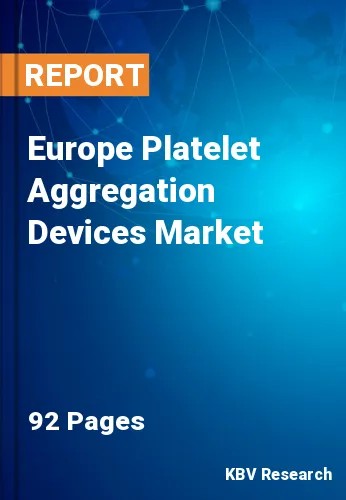The Europe Platelet Aggregation Devices Market would witness market growth of 5.2% CAGR during the forecast period (2023-2030).
The fusion of molecular and functional data provides a more comprehensive understanding of platelet function. It goes beyond assessing how platelets behave in isolation and considers the genetic factors contributing to their responses. This comprehensive approach offers a more holistic view of the factors influencing platelet function. By integrating genetic insights, healthcare providers can move towards more personalized medicine. Understanding the genetic variations that affect platelet function enables tailored treatment strategies. This personalized approach ensures that interventions are based on functional assessments and consider the individual's genetic predispositions.
Moreover, an intriguing innovation on the horizon is the exploration of biohybrid robots for platelet function assessment. This cutting-edge approach combines biological components with artificial elements, presenting new possibilities for organic interactions and medical applications. Biohybrid robots may usher in a new era of nuanced platelet function analysis. Biohybrid robots offer the potential for dynamic and real-time interactions with platelets. This capability enables researchers and healthcare professionals to observe and analyze platelet behavior in more lifelike conditions, moving beyond static assessments.
According to Eurostat, Germany had the highest level of current healthcare expenditure among the EU Member States, valued at €432 billion in 2020. France procured the second highest level of current healthcare expenditure (€281 billion), followed by Italy (€160 billion) and Spain (€120 billion). For healthcare providers, the largest increase in expenditure between 2012 and 2020 in 11 EU Member States (for example, in Romania) was for hospitals, while in three more (for example, in Lithuania), it was for ambulatory healthcare providers. Moreover, the UK's medical technology sector has experienced continuous innovation and technological advancements. These developments translate into introducing more sophisticated and accurate these devices that meet the evolving needs of healthcare professionals. Thus, Europe's rising healthcare and medical technology sectors will boost the demand for these devices in the region.
The Germany market dominated the Europe Platelet Aggregation Devices Market by Country in 2022, and would continue to be a dominant market till 2030; thereby, achieving a market value of $76.4 Million by 2030. The UK market is exhibiting a CAGR of 4.4% during (2023 - 2030). Additionally, The France market would experience a CAGR of 6% during (2023 - 2030).
Free Valuable Insights: The Global Platelet Aggregation Devices Market will Hit $1.1 Billion by 2030, at a CAGR of 5.5%
Based on Product, the market is segmented into Consumables & Accessories, and Systems & Instruments. Based on End-Use, the market is segmented into Research & Academic Institutes, Hospital, and Diagnostic Centers. Based on Application, the market is segmented into Research, and Clinical. Based on countries, the market is segmented into Germany, UK, France, Russia, Spain, Italy, and Rest of Europe.
By Product
By End-Use
By Application
By Country
Our team of dedicated experts can provide you with attractive expansion opportunities for your business.

